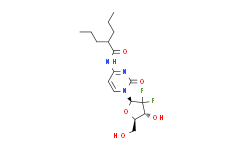| Cas No.: | 892128-60-8 |
| Chemical Name: | Cytidine, 2'-deoxy-2',2'-difluoro-N-(1-oxo-2-propylpentyl)- |
| Synonyms: | LY2334737;N-[1-[(2R,4R,5R)-3,3-difluoro-4-hydroxy-5-(hydroxymethyl)oxolan-2-yl]-2-oxopyrimidin-4-yl]-2-propylpentanamide;LY-2334737;YLR364XYSA;Cytidine, 2'-deoxy-2',2'-difluoro-N-(1-oxo-2-propylpentyl)-;DB12906;Q27294578;1-(2,2-difluoro-2-deoxy-beta-D-ribofuranosyl)-4-(2-propyl-1-oxopentyl)aminopyrimidin-2-one |
| SMILES: | FC1([C@]([H])(N2C(N=C(C([H])=C2[H])N([H])C(C([H])(C([H])([H])C([H])([H])C([H])([H])[H])C([H])([H])C([H])([H])C([H])([H])[H])=O)=O)O[C@]([H])(C([H])([H])O[H])[C@@]1([H])O[H])F |
| Formula: | C17N3O5F2H25 |
| M.Wt: | 389.3943 |
| Sotrage: | 2 years -20°C Powder, 2 weeks 4°C in DMSO, 6 months -80°C in DMSO |
| Description: | LY2334737 is an orally available prodrug of gemcitabine which is a nucleoside analog used as chemotherapy.IC50 Value:Target: Nucleoside analogin vitro: Five cell lines that express CES2 responded to LY2334737treatment. LY2334737 was less cytotoxic to a SK-OV-3 CES2 knockdown than parental cells. The drug response of CES2-transfected HCT-116 cells correlated with CES2 expression level. Bystander studies showed statistically greater PC-3-GFP growth inhibition by LY2334737 when cells were cocultured with CES2 and not mock transfectants [1].in vivo: Oral treatment of xenograft models with 3.2 mg/kg LY2334737 once a day for 21 days showed greater tumor growth inhibition of CES2 transfectant than the mock transfectant (P ≤ 0.001) [1]. The MTD was 40 mg LY2334737. Fatigue was the most frequent DLT for LY2334737monotherapy (4 patients) followed by elevated transaminase levels (2 patients), both observed at the 40- to 50-mg dose levels. Among the 10 patients in the combination arm, 2 had DLTs at the 40-mg dose level. These were fatigue and elevated liver enzyme levels [2]. Metronomic LY2334737 administration caused increased blood flow in luciferase-tagged LM2-4 tumor xenografts, and this effect, readily measured using contrast micro-ultrasound, coincided with a relative increase in tumor bioluminescence [3]. |

 To enhance service speed and avoid tariff delays, we've opened a US warehouse. All US orders ship directly from our US facility.
To enhance service speed and avoid tariff delays, we've opened a US warehouse. All US orders ship directly from our US facility.





















